As a follow-up to our August 2012 evaluation of budget-friendly marine audio systems, we recently tested five mid-priced marine stereos, three of which came kitted with speakers. The products in this round of testing retail for $180 to $350 and are a step up in quality, water-resistance, and features from the stereo-speaker packages ($200 or less) we reviewed last year.
What We tested
A quality stereo designed for the marine environment should be corrosion resistant, with coated circuit boards and no ferrous parts. While few sailboat owners mount their stereos in the cockpit-or need a fully waterproof unit-its still good practice to find one that is marinized and at least splashproof. With that in mind, we limited this test field to stereos rated IPX5 or higher, meaning they should at least be able to tolerate being sprayed with water from a nozzle. This ruled out most stereos and speakers designed for car installations.
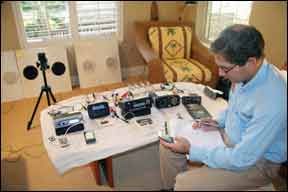
The test field, which represented a cross-section of widely available, mid-priced marine stereos, featured products from Dual Electronics Corp., Milennia, Poly-Planar, Sony, and Fusion Electronics Inc. Dual is a major supplier of low- to mid-priced auto and marine stereos and speakers. Milennia products are offered by South Carolina-based Prospec Electronics, a 20-year-old company with a large line of high-quality, all-weather audio electronics. Poly-Planar, a Maryland company, specializes in marine audio systems and has a complete line of high-end waterproof stereos, speakers, and accessories. Electronics-giant Sony is a global company that manufactures a number of marine-specific products. The New Zealand-based Fusion offers a line of high-quality marine entertainment systems, and the company has links with other electronics companies such as Garmin and Raymarine.
All the test stereos are standard flush-mount, in-dash type units with AM/FM receivers. The Poly-Planar and Sony stereos have flip-down front plates that protect the inputs for CDs, SD cards, and iPods, while the Dual has a detachable front plate that seems more for security than protection from the elements. We recommend storing the faceplate ashore when its not in use. This will add to its longevity, as will coating exposed connections with corrosion-inhibiting sprays that are safe on plastics, like TC-11 or CRC Heavy Duty (PS, September 2007).
Of the five mid-priced marine stereos we tested, three came bundled with 6.5-inch speakers: Dual, Fusion, and Milennia. A speakers sound quality and range are, in part, determined by what type of speaker it is. Both the Fusion and Milennia speakers are coaxial, and the Dual features polypropylene dual cones. Dual-cone speakers deliver sound using a small cone for high frequencies and a large cone for mid-range and low frequencies. A coaxial speaker is essentially a woofer (for mid and low frequencies) wrapped around a tweeter (for high frequencies). Typically, coaxial speakers offer better sound than dual cone. All the test speakers have water-resistant plastic faceplates and housings, stainless-steel hardware, and injection-molded polypropylene or poly-carbon cones; none had polarity switches. They all included about 12 feet of speaker cable.
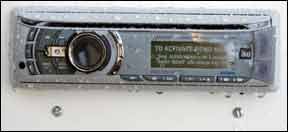
The test stereos all can produce 15 to 20 RMS watts of audio power, per channel, which should be plenty for any small or mid-size sailboat, anchored or underway. Because each test unit has a long laundry list of features and functions, we did not attempt to describe them all in detail. The accompanying Features table highlights each units basic features and functions. The Dual and Sony units include CD players, while the Poly-Planar has an internal iPod/iPhone dock, and the Fusion has an external dock. As weve noted in the past, unless you have an irreplaceable library of CDs or lots of money to spend replacing stereos, a unit without a CD player is a more practical choice for on-board audio. CD players draw more power, eventually wear out, and are very susceptible to failure in a humid or salty environment. Similarly, if you don’t have or plan to use an iPhone/iPod, you may not want the dock or slot for it as it would be an unnecessary potential failure point.
All of the test units have an auxiliary port (either 3.5 millimeter and/or RCA jacks) for analog input, and all can receive digital audio from a computer or MP3 device via a USB port. The Dual and Poly-Planar units have SD card readers, and they accept input from a Sirius radio, as do the Sony and Fusion. The Dual and Milennia also have Bluetooth audio streaming capability. The Dual and Sony stereos come with wireless, infrared remotes, which offer line-of-sight control of the stereo.
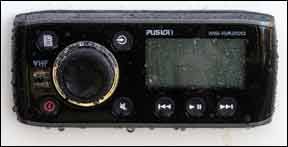
The Dual and Fusion units can monitor the NOAA weather broadcasts and some VHF channels. While this is a nice bonus feature, most boat owners have, or should have, an onboard VHF radio for monitoring these channels.
Dual AMCP600W
The AMCP600W came as a package with DMP67 speakers, but many retailers sell just the receiver for about $180; the speaker set costs about $50 and is the same as the one we tested with the Dual AMCP400W in the 2012 review.
Installing the Dual AMCP600W in a fiberglass bulkhead requires bending the thin metal tabs of a mounting sleeve, with no means of bolting the unit snug against the panel. Testers added some angle brackets, but it was still loose. While troubleshooting the problem, we read in the 38-page owners manual that a separately sold installation kit may be required.
The AMCP600W is considered Duals top-of-the line stereo. Its Sirius ready, has a CD player, is MP3/WMA compatible, and has built-in Bluetooth and direct USB control of iPod/iPhones. It comes with a microphone and circuitry for hands-free telephone operation. Testers rated its audio quality and operation as Good.
Its detachable faceplate, which is made of UV-resistant ABS plastic, plugs into the main housing with a 12-pin connector and comes with a plastic storage case for safekeeping and transport. The front auxiliary and USB ports have silicone splash plugs tethered with thin threads, but when the faceplate is removed-as would likely be the case when youre off the boat-the CD and SD-card slots are left exposed.
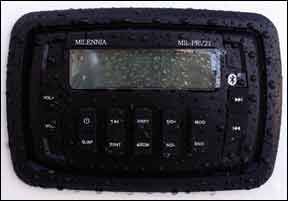
The faceplate design seemed to be the Duals Achilles heel in our spray test. Even though its rated IPX5, a fair bit of water leaked behind the faceplate during the test, and the stereo failed to work properly after that. We could not turn it off, and it jumped from input source to input source. Even after drying out for an hour, it would not stay on an FM station for more than one minute. It was the only test stereo whose performance was affected by the spray test.
The stereo back has a 16-pin plug and multiple wire harnesses, plus two sets of RCA jacks for preamp output. When wiring the Dual, pay attention to the color-coding; it can get confusing as the three power wires are mixed in with the eight speaker wires.
Bottom line: The least expensive in the test group, the Dual is a decent-sounding combo package with a great price, but it was held back by installation challenges and its vulnerability to water damage.
Fusion MS-RA200SD
Fusion is known for its innovative products specifically designed for the marine environment. The MS-RA200SD is a compact, weatherproof stereo-speaker package with a long list of features, highlighted by an external iPod dock and VHF monitoring capability. Its multi-zone volume control allows users to have one volume setting on deck and another in the cabin.
The large, backlit, dot-matrix LCD display handles up to 72 characters and will replicate all MP3-player menu items. The waterproof, aluminum-coated housing features rubberized buttons and is designed to resist UV, moisture, salt, and vibration.
The two MS-FR6520 coaxial, waterproof speakers have heavy magnets and can handle 200 watts at a clear 80 Hz-20 KHz. The package had excellent sound with crisp, clear highs and lows. Testers found these speakers to have the best sound in the field, so we also used them to test the Poly-Planar and Sony stereos, which came without speakers.
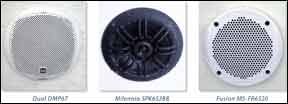
Bottom line: Compact and easy to install, the bullet-proof Fusion comes with excellent coaxial speakers. The feature-loaded stereo gets PSs Best Choice and Budget Buy.
Milennia MIL-MPK 21
The Milennia MIL-MPK 21 package comprises the PRV21 stereo receiver and the SPK652BB speakers. This compact, rugged unit has no CD player or NOAA weather-band stations, but it proved to be very watertight, with rubberized buttons and no slots or receptacles on its front. The Milennia was the only test product with no mechanical music device-iPod dock or CD player, etc.-and it drew the least power.
Audio was crisp and clear, and the FM sensitivity was excellent The wires for the speakers and power connect to a square 12-pin male plug. Although it comes standard with the package, the female plug was missing from our test unit, so we had to cut and splice the wiring. Other inputs and outputs, such as auxiliary, USB, and a 3.5-millimeter jack are weatherproof with appropriate caps. The display has big, black characters on a light blue background.
The Milennia was the only test stereo that offers an optional radio-frequency remote that can control the stereo from about 30 feet away, and not line-of-sight. This means users can easily control a cabin-mounted stereo from the helm.
The owners manual is skimpy in detail, but operation is intuitive. Installation was fast and easy, with a well-designed mounting bracket and the easiest to use cut-out template of the test field.
Bottom line: The Milennia was one of the top overall performers, but it lacks some of the features of the Fusion. It earned PSs Recommendation for those looking for a smaller unit and those who can live without a CD player or iPod dock.
Poly-Planar MRD 80i
The Poly-Planar MRD 80i proved to be very weather resistant thanks to rubberized buttons, substantial gaskets on the flip-down faceplate, and a protective plastic front cover. Its SD-card reader and iPod dock are behind the flip-down faceplate, and the other inputs are on the back. It offered an Excellent, rich sound.
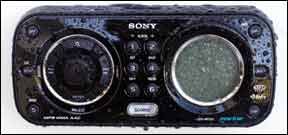
While some water got behind the faceplate in the spray test, there was no noticeable effect on the stereos performance.
The unit comes with a well-written and organized 24-page manual with clear drawings and wiring diagrams. However, testers rated ease of installation as Fair because the cut-out template was too small to fit the radio.
The most expensive stereo in the test, the MRD 80i was the only stereo with a two-year warranty; all others carry only one-year warranties. After testing was complete, Poly-Planar released an improved version of this unit. The new MR085i lists for $400 and offers Bluetooth streaming, among other features not included with the MR80i.
Bottom line: A bit pricey-even though it doesn’t come with speakers-the MRD80is excellent audio and quality construction earn it PSs Recommendation.
Sony CDX-H910U1
The sophisticated Sony CDX-H910UI is capable of 52 peak watts per channel. Its CD player opening is behind the flip-down faceplate and has a rubber splash-proof gasket, a more marine-friendly design than the Duals, which has an exposed CD slot in the stereo front.
The 3.5-millimeter auxiliary input has a tetherless silicone plug. Input circuits can accommodate MP3, WMA, and Sirius XM radio. The Sony comes with a jack for the Sirius input and another for an optional external wired remote control. The housing is rated as UV, salt, and IPX5 water resistant, but in the spray test, a few water droplets found their way behind the faceplate; none reached the electrical connections.
The 2-inch round display has a continuously moving sound-level bar. Like the Poly-Planar, the Sonys powering on or off wasnt immediate when a user pushed the button.
The Sonys tuner sensitivity and sound quality were Excellent. Functional programming is extensive-sometimes inhibiting intuitiveness. Along with a 125-page manual, the Sony comes with a large wiring/installation sheet and a cut-out template that testers found less than user friendly.
The unit came with a large yellow caution sticker (an obvious afterthought) saying: Attach the supplied cushion in the position of figure, with no explanation for its purpose. Our guess is that the cushion, which is about an inch long and has a sticky back, pushes up the cover to allow better ventilation from the metal case in the back.
The front panel is a nice, shiny black plastic, but judging by the warnings included with it-do not clean with anything over 86 degrees, avoid installing in sunlight or areas subject to water splashes-it may be somewhat delicate.
Bottom line: A quality stereo with lots of features, the Sony was out-performed by the easy-to-install and very water-resistant Milennia and Fusion.
Conclusion
All of the stereo units are worth considering for on-board use, although we caution against mounting the Dual in a potentially damp location. They all produced good-to-excellent audio quality, performed as marketers claim, and were fairly easy to install. The most robust and moisture-resistant stereos were the Milennia and the Fusion.
The marine speakers we tested also were all very good. The Fusion coaxial speakers appeared to be the most durable, had the heaviest magnets, and handled high volume the best. The Milennia speakers produced excellent sound as well, earning a very-close second favorite pick.
How you store your music and want to access it-on CDs, an MP3 player, a Bluetooth smartphone, a USB drive, etc.-will ultimately determine which of these stereos best matches your needs.
The Dual package is certainly feature rich and the most economical. It was high on the favorites list, despite problems installing it, until it stopped working after our spray test. The Sony model is also feature loaded and produced great sound, but other stereos out performed it in tests.
The most expensive of the test stereos, the Poly-Planar also had the most heavy-duty construction and was rated well in tests. We Recommend it for those who want a hidden iPhone/iPod device and can invest a little a more for Excellent audio quality and durability.
Deciding on a Best Choice was tough. Both the Milennia and Fusion are compact, easy to install, very waterproof, and are built to quality standards-plus both are packaged with coaxial speakers that sound great.
The Milennia is unique to allow RF remote control and will accept Bluetooth wireless streaming. On the other hand, the Fusion features NOAA weather and VHF monitoring, is Sirius ready, and has a separate dock for any iPhone/iPod device, a larger display with more information, and multi-zone volume control.
In the end, the top pick-and the Budget Buy-went to the Fusion, with the Milennia close behind, earning a PS Recommendation.




































